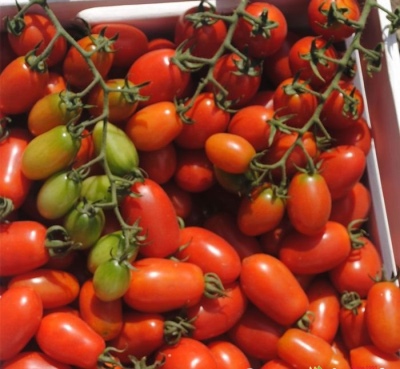
- Category: hybrid
- Growth type: indeterminate
- Appointment: universal
- Ripening period: early
- Ripening time, days: 90-95
- Growing conditions: for open ground, for closed ground
- Bush size: tall
- Bush height, cm: about 200
- Ripe fruit color: Red
- Fruit shape: ovoid, with a small "spout" at the top
For lovers of mini tomatoes, delicious cherry fruits are suitable. Of the large number of such tomatoes, the cherry hybrid Sasha stands out, which has a lot of advantages. First of all, it bears fruit abundantly, and is also resistant to heat and cold weather. And the excellent taste and marketability attracts many gardeners.
Description of the variety
Cherry Sasha is a tall, indeterminate hybrid that grows both in open and closed ground up to 200 cm and more. Differs in moderate foliage. It has simple inflorescences, stems with articulation. At the same time, the brushes are shortened. They have 15-30 cherry fruits each. Of the advantages, it can be noted:
- good portability;
- fruits can be stored for up to a month;
- ripen amicably;
- the yield is stable;
- high immunity;
- resistance to high and low temperatures.
There are also disadvantages: tomatoes need to be fed and shaped.
The main qualities of the fruit
Small fruits of cherry Sasha have the shape of an egg, with a small "nose" at the top. The color of the tomatoes is bright red, there are about 25 tomatoes on shortened clusters. The weight of one fruit is 30–40 g. The pulp has a dense glossy skin, two seed chambers, there are few seeds in them.
Taste characteristics
Miniature cherry fruits Sasha are distinguished by their excellent taste with a touch of sweetness, they have tender, juicy, aromatic pulp. They are dense; when canning, the skin will not crack. Vegetables of the described variety are useful, as they contain many vitamins (A, E, K and group B). There are macronutrients such as potassium, phosphorus and sodium, magnesium and chlorine, sulfur and calcium, as well as trace elements: copper, manganese, fluorine and iodine, zinc and iron.
Ripening and fruiting
Cherry Sasha is an early ripening hybrid in terms of ripening (90–95 days). The harvest is in July and August.
Yield
Official sources indicate a high yield of the hybrid variety. Cherry Sasha can bear from 12 to 14 kg of fruits from 1 m 2 of the plantation.
The timing of planting seedlings and planting in the ground
Cherry tomato Sasha is grown in seedlings. Purchased seeds (since this is a hybrid, and you won't be able to use your seeds) are planted in March - April. The optimum temperature for seed germination is 23–25 ° C. Seedlings are planted in the ground at the age of 60–70 days in May – June.

Growing tomato seedlings is an extremely important process, because it largely depends on whether the gardener can harvest at all. All aspects must be taken into account, from seedbed preparation to planting in the ground.
Landing scheme
When planting plants in a permanent place on an area of 1 sq. m place no more than 3 plants. The holes are made to a depth of 30 cm. Compost, ash, superphosphate, potassium sulfate are added to the bottom of the hole.

Growing and care
Growing cherry tomatoes is not a very difficult task.In this sense, cherry Sasha is no exception. An indeterminate bush is formed, as a rule, in 1–2 stems. Experts recommend staying on one stem.
And you will also need pinning, a garter to a strong support or trellis. Pinching of the tops is obligatory. Cherry fruits can be picked with whole brushes.
The hybrid variety responds well to irrigation, feeding with complex mineral fertilizers. Moderate watering with settled water is required, only at the root. Fertilizers and fertilizing are carried out with complex formulations of the Agricola type, and phosphorus-potassium-nitrogen fertilizers will also be required.
To speed up the process of seed germination, improve the health of plants, and improve fruit set, experienced gardeners recommend using specially designed stimulants for the growth and development of fruit plants.




A plant needs different micronutrients at each stage of growth. All fertilizers can be divided into two groups: mineral and organic. Folk remedies are often used: iodine, yeast, bird droppings, eggshells.
It is important to observe the rate and period of feeding. This also applies to folk remedies and organic fertilizers.
Disease and pest resistance
Cherry hybrid Sasha has good resistance to fruit cracking, and also has excellent immunity to tobacco mosaic virus (TMV).



























































































